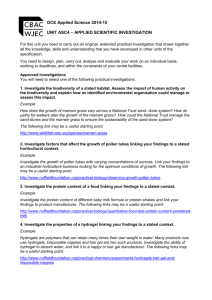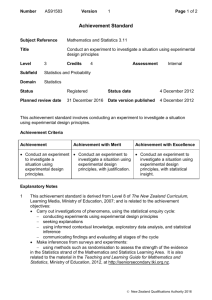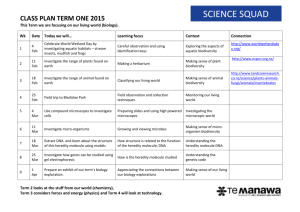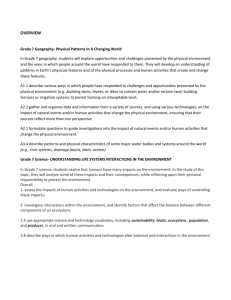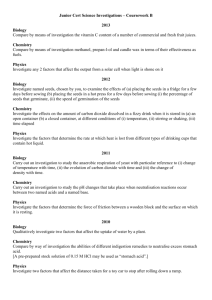Examples of Unit 4 Investigations
advertisement
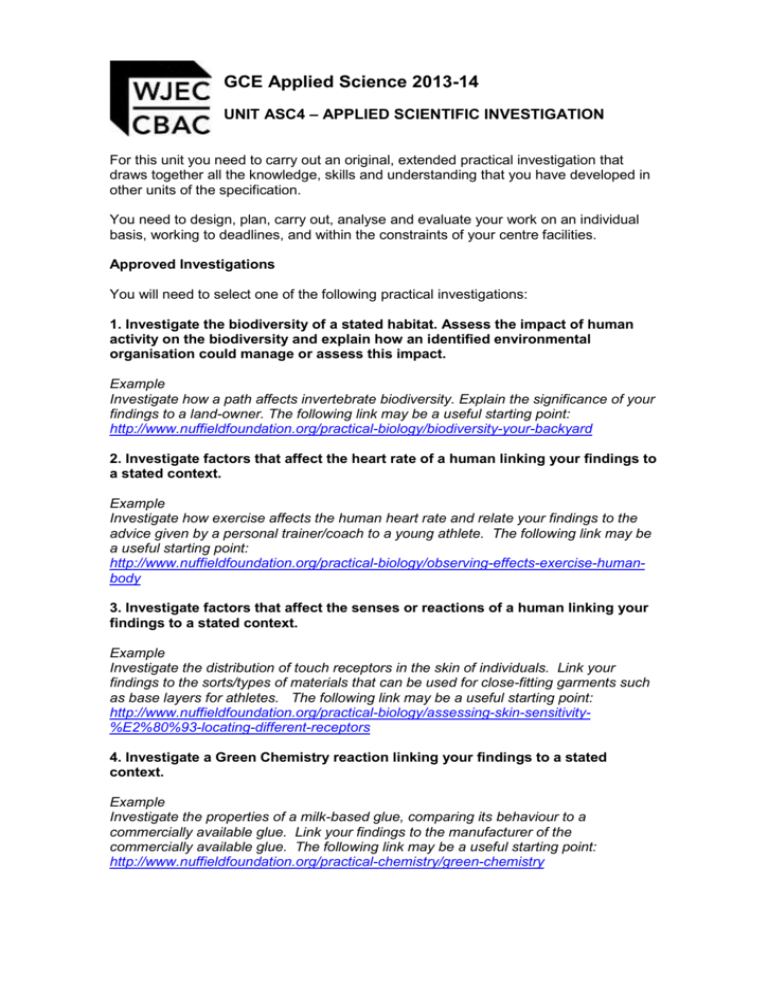
GCE Applied Science 2013-14 UNIT ASC4 – APPLIED SCIENTIFIC INVESTIGATION For this unit you need to carry out an original, extended practical investigation that draws together all the knowledge, skills and understanding that you have developed in other units of the specification. You need to design, plan, carry out, analyse and evaluate your work on an individual basis, working to deadlines, and within the constraints of your centre facilities. Approved Investigations You will need to select one of the following practical investigations: 1. Investigate the biodiversity of a stated habitat. Assess the impact of human activity on the biodiversity and explain how an identified environmental organisation could manage or assess this impact. Example Investigate how a path affects invertebrate biodiversity. Explain the significance of your findings to a land-owner. The following link may be a useful starting point: http://www.nuffieldfoundation.org/practical-biology/biodiversity-your-backyard 2. Investigate factors that affect the heart rate of a human linking your findings to a stated context. Example Investigate how exercise affects the human heart rate and relate your findings to the advice given by a personal trainer/coach to a young athlete. The following link may be a useful starting point: http://www.nuffieldfoundation.org/practical-biology/observing-effects-exercise-humanbody 3. Investigate factors that affect the senses or reactions of a human linking your findings to a stated context. Example Investigate the distribution of touch receptors in the skin of individuals. Link your findings to the sorts/types of materials that can be used for close-fitting garments such as base layers for athletes. The following link may be a useful starting point: http://www.nuffieldfoundation.org/practical-biology/assessing-skin-sensitivity%E2%80%93-locating-different-receptors 4. Investigate a Green Chemistry reaction linking your findings to a stated context. Example Investigate the properties of a milk-based glue, comparing its behaviour to a commercially available glue. Link your findings to the manufacturer of the commercially available glue. The following link may be a useful starting point: http://www.nuffieldfoundation.org/practical-chemistry/green-chemistry 5. Investigate a scientific process involving the use of water linking your findings to a stated context. Example The hardness of water can be investigated, measuring the amount dissolved calcium or magnesium salts in the water – this affects its properties (and taste). Water from different sources can be investigated and the findings linked to problems of ‘scale’ forming in domestic appliances or pipes. The following link may be a useful starting point: http://www.nuffieldfoundation.org/practical-chemistry/testing-hardness-water 6. Investigate the electrical and/or mechanical behaviour of a commercially/scientifically useful material Example The mechanical properties of polythene or fishing line under tension can be investigated. The findings of the experiments can be related to the application of supermarket bags or angling. The following link may be a useful starting point: http://www.nuffieldfoundation.org/practical-physics/stretching-rubber Vocational context Although the titles above are set, the practical investigation must be set in a particular vocational context which is of your choosing. Therefore, you need to identify an example where your chosen title can be APPLIED specifically in relation to the work of a local business or organisation. This does not preclude national or even international businesses or organisations, but the link to the local level must be made. It is, therefore, important that you plan an investigation which is directly applicable in a local vocational context and that you also relate your findings to the purpose of the investigation and its applied context. GCE Applied Science 2013-14 UNIT ASC4 – APPLIED SCIENTIFIC INVESTIGATION Supervision of practical work Your work should, as far as possible, be carried out under controlled, supervised conditions. Laboratory practical work should be supervised at all times. If there is any work which is, of necessity, unsupervised e.g. a visit to local industry, details should be noted by you in your lab-diary and by your supervisor on the report coversheet. In some circumstances, it may not be feasible to supervise work e.g. fieldwork such as river surveys, however a photographic record of you carrying out the work should be included in your lab-diary. Note you should not undertake fieldwork alone, in accordance with CLEAPSS guidelines. Written work, such as your lab-diary, should be handed in and kept by your teacher outside supervised time. Writing your report You should write a detailed report of your investigation which should include: Detailed aims A plan, linked to other areas of the AS/A level specification A record of your carrying out the investigation Information from the lab-diary and any other sources fully referenced, with relevant parts of the lab diary included as appendices Suitably presented and processed data Evaluation of your results and methods used. Presentation of the outcomes and conclusions related to the context and aims. The report should be clear, logical, well structured and concise. You should use an appropriate format e.g. tables, graphs, correct scientific terminology and accurate spelling, punctuation and grammar. Your report must be written under supervised conditions, taking no more than 5 hours. Redrafting of the work is not permissible. Both the investigation and report must be authenticated by you and your supervisor as being solely your own work. Marking Your completed investigation report (plus coversheets) will be submitted to WJEC for external marking. The work should therefore be submitted by the given deadline. GCE Applied Science 2013-14 UNIT ASC4 – APPLIED SCIENTIFIC INVESTIGATION Teacher Guidance Approved Investigations The Investigations listed here are examples only. Although the titles are set, the actual context is not. Candidates should be encouraged to find LOCAL examples where the title can be APPLIED specifically in relation to a local business/organisation/setting. This does not preclude national or even international businesses or organisations, but the link to the local level must be made. It is intended that all candidates in a centre will be doing different examples of the investigation, e.g. if two or more candidates want to investigate the factors that affect the heart rate of a human, it is envisioned that one will be investigating the effect of caffeine and the other will be investigating the effect of exercise.. 1. Investigate the biodiversity of a stated habitat. Assess the impact of human activity on the biodiversity and explain how an identified environmental organisation could manage or assess this impact. Example Investigate how a path affects invertebrate biodiversity. Explain the significance of your findings to a land-owner. The following link may be a useful starting point: http://www.nuffieldfoundation.org/practical-biology/biodiversity-your-backyard Ideas for Teachers: Students could use results from an experimental simulation programme to COMPARE to their results. Other experiments that could be used include: How does the growth of marram grass vary across a National Trust sand-dune system? Freshwater biodiversity and pollution http://www.nuffieldfoundation.org/practical-biology/monitoring-water-pollutioninvertebrate-indicator-species Investigate the response of worms to soil improvers http://www.nuffieldfoundation.org/practical-biology/investigating-response-worms-soilimprovers 2. Investigate factors that affect the heart rate of a human linking your findings to a stated context. Example Investigate how exercise affects the human heart rate and relate your findings to the advice given by a personal trainer/coach to a young athlete. The following link may be a useful starting point: http://www.nuffieldfoundation.org/practical-biology/observing-effects-exercise-humanbody Ideas for Teachers: Other experiments that could be used include: Effect of caffeine (fizzy drinks / energy drinks / coffee) Effect (or not) of age / gender / ‘fitness’ 3. Investigate factors that affect the senses or reactions of a human linking your findings to a stated context. Example Investigate the distribution of touch receptors in the skin of individuals. Link your findings to the sorts/types of materials that can be used for close-fitting garments such as base layers for athletes. The following link may be a useful starting point:http://www.nuffieldfoundation.org/practical-biology/assessing-skin-sensitivity%E2%80%93-locating-different-receptors Ideas for Teachers: Other experiments that could be used include: Colour-blindness. Peripheral vision. Resolution. Hearing range (frequency). Taste / smell tests. Balance tests. 4. Investigate a Green Chemistry reaction linking your findings to a stated context. Example Investigate the properties of a milk-based glue, comparing its behaviour to a commercially available glue. Link your findings to the manufacturer of the commercially available glue. The following link may be a useful starting point: http://www.nuffieldfoundation.org/practical-chemistry/green-chemistry Ideas for Teachers: Other experiments that could be used include: Making and testing the properties of bio-plastics. Making and testing the properties of bio-fuels. Investigating ‘bouncing custard’ 5. Investigate a scientific process involving the use of water linking your findings to a stated context. Example The hardness of water can be investigated, measuring the amount dissolved calcium or magnesium salts in the water – this affects its properties (and taste). Water from different sources can be investigated and the findings linked to problems of ‘scale’ forming in domestic appliances or pipes. The following link may be a useful starting point: http://www.nuffieldfoundation.org/practical-chemistry/testing-hardness-water Ideas for Teachers: Other experiments that could be used include: Conductivity of water. Solubility experiments. Refractive index experiments – contact lens lubricant Specific saline gravity (floating in the Dead Sea / Plimsoll Line) Specific latent heat, specific heat capacity 6. Investigate the electrical and/or mechanical behaviour of a commercially/scientifically useful material Example The mechanical properties of polythene or fishing line under tension can be investigated. The findings of the experiments can be related to the application of supermarket bags or angling. The following link may be a useful starting point: http://www.nuffieldfoundation.org/practical-physics/stretching-rubber Ideas for Teachers: Other experiments that could be used include: Electrical resistivity Density Breaking stress Stress-strain behaviour A range of different materials could be tested from metals through to pasta, chocolate and biscuits! A writing frame can also be found on the WJEC GCE Applied Science web page. Centres are reminded that learners need to complete a hand written plan of the investigation before commencing the investigations The work will be marked by the WJEC and will need to be with the examiner in early May (please see the Examination Timetable for the final submission date). A copy of the generic mark scheme can be found on page 45 of the specification found at http://www.wjec.co.uk/uploads/publications/12660.pdf Teachers are referred to page 38-44 of the specifications for further guidance on this unit.
